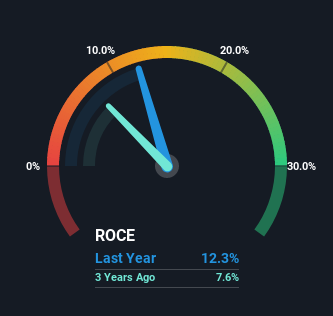- United States
- /
- Chemicals
- /
- NYSE:DOW
Dow (NYSE:DOW) Shareholders Will Want The ROCE Trajectory To Continue

What are the early trends we should look for to identify a stock that could multiply in value over the long term? Firstly, we'd want to identify a growing return on capital employed (ROCE) and then alongside that, an ever-increasing base of capital employed. Basically this means that a company has profitable initiatives that it can continue to reinvest in, which is a trait of a compounding machine. So when we looked at Dow (NYSE:DOW) and its trend of ROCE, we really liked what we saw.
Return On Capital Employed (ROCE): What Is It?
For those who don't know, ROCE is a measure of a company's yearly pre-tax profit (its return), relative to the capital employed in the business. Analysts use this formula to calculate it for Dow:
Return on Capital Employed = Earnings Before Interest and Tax (EBIT) ÷ (Total Assets - Current Liabilities)
0.12 = US$6.1b ÷ (US$61b - US$11b) (Based on the trailing twelve months to December 2022).
Therefore, Dow has an ROCE of 12%. In absolute terms, that's a pretty normal return, and it's somewhat close to the Chemicals industry average of 11%.
View our latest analysis for Dow

Above you can see how the current ROCE for Dow compares to its prior returns on capital, but there's only so much you can tell from the past. If you'd like, you can check out the forecasts from the analysts covering Dow here for free.
The Trend Of ROCE
Dow has not disappointed in regards to ROCE growth. The figures show that over the last four years, returns on capital have grown by 50%. The company is now earning US$0.1 per dollar of capital employed. Interestingly, the business may be becoming more efficient because it's applying 28% less capital than it was four years ago. If this trend continues, the business might be getting more efficient but it's shrinking in terms of total assets.
The Bottom Line On Dow's ROCE
In the end, Dow has proven it's capital allocation skills are good with those higher returns from less amount of capital. And a remarkable 111% total return over the last three years tells us that investors are expecting more good things to come in the future. Therefore, we think it would be worth your time to check if these trends are going to continue.
Dow does have some risks though, and we've spotted 2 warning signs for Dow that you might be interested in.
If you want to search for solid companies with great earnings, check out this free list of companies with good balance sheets and impressive returns on equity.
New: Manage All Your Stock Portfolios in One Place
We've created the ultimate portfolio companion for stock investors, and it's free.
• Connect an unlimited number of Portfolios and see your total in one currency
• Be alerted to new Warning Signs or Risks via email or mobile
• Track the Fair Value of your stocks
Have feedback on this article? Concerned about the content? Get in touch with us directly. Alternatively, email editorial-team (at) simplywallst.com.
This article by Simply Wall St is general in nature. We provide commentary based on historical data and analyst forecasts only using an unbiased methodology and our articles are not intended to be financial advice. It does not constitute a recommendation to buy or sell any stock, and does not take account of your objectives, or your financial situation. We aim to bring you long-term focused analysis driven by fundamental data. Note that our analysis may not factor in the latest price-sensitive company announcements or qualitative material. Simply Wall St has no position in any stocks mentioned.
About NYSE:DOW
Dow
Through its subsidiaries, engages in the provision of various materials science solutions for packaging, infrastructure, mobility, and consumer applications in the United States, Canada, Europe, the Middle East, Africa, India, the Asia Pacific, and Latin America.
Good value with adequate balance sheet.


